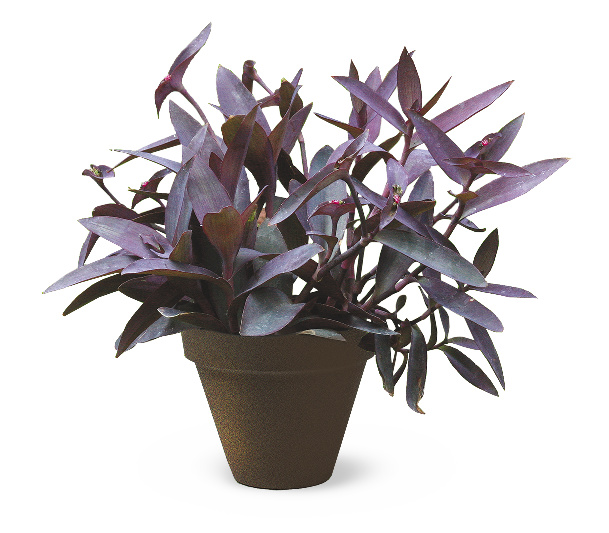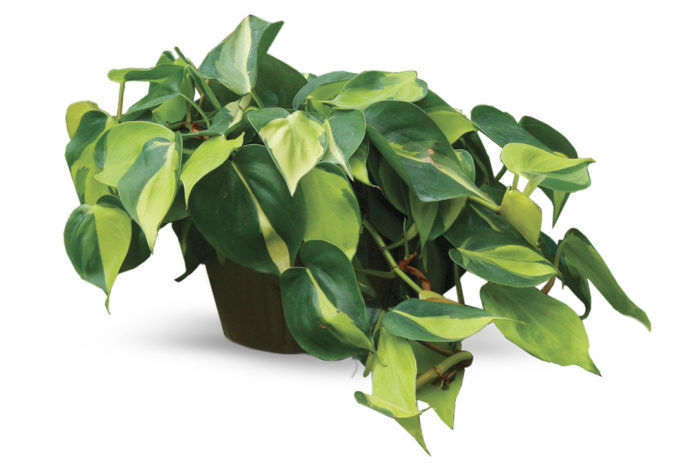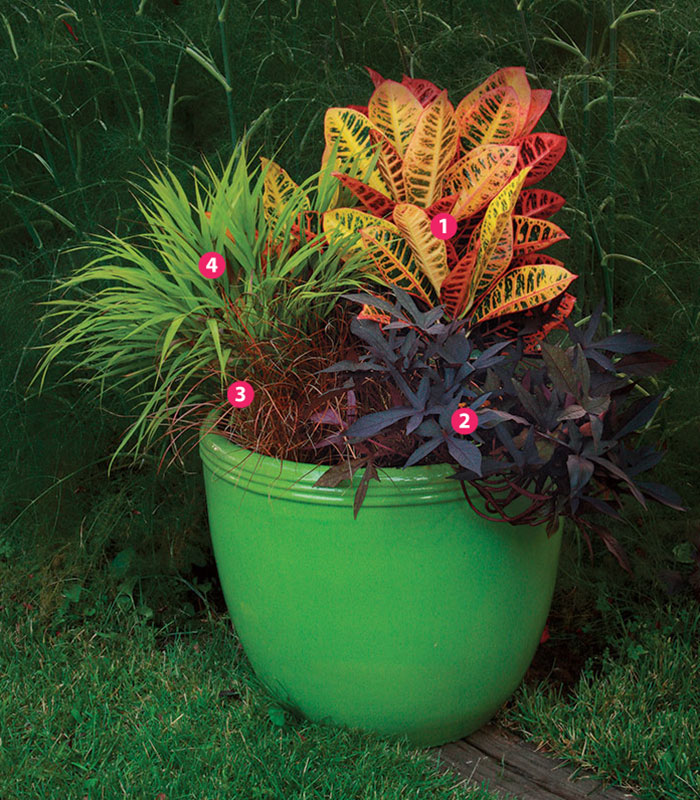Put Your Houseplants in Your Outside Containers
Indoor plants make exciting additions to shady outdoor pots

We all enjoy a vacation, right? Well, houseplants can benefit from a change of venue, too, but their vacation destination doesn’t need to be limited to an out-of-the-way, sometimes forgotten corner of your garden or patio. And you need not be compelled to keep them in the same pots they occupy indoors. In return for their stalwart service all winter, houseplants deserve a little creative liberation, so think of them as candidates for some eye-catching combinations in your outdoor summer pots. Some houseplants offer as much, if not more, visual punch as many more traditional container plants, especially when you’re designing containers for shade. Many houseplants are native to the shady, moist forest floor in warm parts of the world. That preference enables them to survive in the often dimly lit parts of our heated homes in which we grow houseplants. It also makes them perfect for the shade in your garden.
Let their indoor preferences be your guide
When planning outdoor combinations with houseplants, it helps to remember a few important cultural points about growing these plants outside. As a general guide, provide similar conditions outdoors as you do indoors, but be prepared to adjust them as the plants respond to being liberated. Most will need more water outdoors than indoors and will respond positively to the increased outdoor humidity. Also, be prepared to provide more than the usual amount of fertilizer as your plants react to their improved conditions. Many plants that manage to get by indoors under less than optimal conditions will surprise you with their burgeoning growth once taken outside, so experiment with different treatments. The plants will tell you if they’re unhappy. On the other hand, they may dazzle you with unexpectedly luxuriant foliage and maybe even some flowers. More than likely, your houseplants will be happier, healthier, and much bigger by the time you bring them back indoors in fall.
Crotons are a party of tropical colors

Unlike most other houseplants, crotons need quite a bit of light—but not full, blazing sun—to stage their Technicolor foliage displays, whether indoors or out. And more than any other houseplant, crotons can dramatically improve their appearance when grown outside. Place these thirsty, hungry plants in morning sun. They grow slowly but steadily; it will take a couple of years for a small plant to gain impressive stature, so treat yourself to a reasonably large plant to begin with. While most of them are decked out in color combinations suggestive of clown pants, a few wear more subtle shades of mostly green with other colors. All of them make suitable companions for many flowering annuals, but you might want to think twice before pairing vivid crotons with pink and other pastel colors; both might suffer in contrast.
- Croton (Codiaeum variegatum var. pictumcv., USDA Hardiness Zone 11)
- ‘Bright Ideas Black’ sweet potato vine (Ipomoea batatas ‘Bright Ideas Black’, Zone 11)
- ‘Cappuccino’ New Zealand hair sedge (Carex tenuiculmis ‘Cappuccino’, Zones 7–9)
- Japanese forest grass (Hakonechloa macra, Zones 5–9)

Purple heart and tradescantia are two trailing houseplants that beg to be included in outdoor container combinations. Indoors and out, provide bright light and ample moisture in a container that allows them to cascade. The slashing knife blades of purple heart take longer to trail than the dark, iridescent silver lozenges of tradescantia, but they all suggest movement and energy. Flowers of almost every color as well as foliage with yellow and white markings stand out against the houseplants’ dark leaves. Try to keep moving soccer balls and the large wagging tails of dogs away from these plants as their leaves are a little brittle. Like philodendrons and English ivies, these houseplants benefit from some cutting back, which thickens them up and provides cuttings for more plants.

- Purple heart (Tradescantia pallida ‘Purpurea’, Zones 8–11)
- ‘Sinbad’ begonia (Begonia ‘Sinbad’, Zone 11)
- Tradescantia (Tradescantia zebrina, Zone 11)
Rubber plants are bold and dramatic

Rubber plants take a lot of abuse indoors, whether in shopping malls and offices or in the corners of living rooms. Kept too dark and dry, they will inevitably drop their large, leathery, richly colored lower leaves until only a few pathetic upper leaves remain. So give them bright light (a few hours of morning sun will do) and regular waterings. Outdoors do the same, but add a little water-soluble fertilizer to the water every now and then, and hide a sturdy stake up the back of their stems to help protect against wind toppling. Their big, clunky leaves provide a striking contrast to more delicate annuals and foliage plants, and their short-lived but vivid red leaf sheaths provide an opportunity to make a memorable combination with red and other hot-colored flowers and foliage.
*These plants are considered invasive in some areas. Please check invasiveplantatlas.org or your state’s list of invasive plants for more information.
Philodendrons festoon the edges of pots

Languidly trailing philodendrons persist in dark areas and even as cuttings grown only in water. They flourish, however, when given plenty of indirect light and moisture in a loose potting mix—whether indoors or out. These plants are automatic choices for providing energetic, almost whooshing lines and festoons of heart-shaped leaves in green, yellow, white, and silver. Trimming back overly long shoots at the beginning of summer will encourage the plants to send out more stems and to grow more dense; you can root the cuttings in water or potting soil.
- Chinese evergreen (Aglaonema commutatum cv., Zone 11)
- ‘Brasil’ philodendron (Philodendron ‘Brasil’, Zone 11)
- Japanese forest grass (Hakonechloa macra cv., Zones 5–9)
Corn plants are tough, colorful focal points

Another group often relegated to dark, forgotten, rarely watered corners of any indoor setting, corn plants thrive when placed outdoors in a brightly lit spot and given ample water and occasional fertilizer. Leggy specimens missing their lower leaves can be planted low in their pot, and new roots may emerge from the stem. This will make them look less gangly and awkward, and will provide more stability in the face of wind and other hazards. These plants might even be used as supports for gentle climbers, such as the wire vine shown here.
- ‘Warneckii Goldstar’ corn plant (Dracaena fragrans ‘Warneckii Goldstar’, Zone 11)
- Wire vine (Muehlenbeckia complexa, Zones 8–10)
- ‘Trailing Red’ coleus (Solenostemon scutellarioides ‘Trailing Red’, Zone 11)
- ‘Gail’s Choice’ alternanthera (Alternanthera ‘Gail’s Choice’, Zones 9–11)
Move houseplants outdoors gradually in spring
Although they’re generally tough, don’t expect houseplants to adjust to their outdoor quarters immediately. Like seedlings and transplants started indoors, houseplants benefit from some hardening off over a few days—think of it as an adjustment period. Most important, make sure you gradually accustom your houseplants to what is almost certainly brighter light than what they receive indoors.
1. Take them outside
Take them outside on a warmish morning, and leave them there for a few hours under a tree that casts plenty of shade or choose an overcast day; the north side of your house will work too. Bring them back in for the night, then repeat the process over the next few days, each day leaving them outside longer than the previous day. It also helps to choose a spot out of the strong wind during the hardening-off period (remember, they weren’t exposed to strong wind indoors), and don’t let your plants dry out. If you live in a hot region with strong sun, plan to spend more time hardening off your plants than in cooler areas with less intense light.
2. Provide extra root room
Consider providing a little extra root room for your houseplants, whether by increasing the pot size a few inches for individually grown specimens kept in their pots or by combining two or more unpotted plants in a much roomier pot. First, knock the plant out of the pot and inspect the roots. If they are white and not too crowded, go ahead and place them in their new quarters; however, if the roots look brown and are so abundant you can’t easily put your finger between them, it’s time to remove some of the biggest, thickest roots by carefully pulling or cutting them.
Do this after you’ve hardened them off for a few days, then give them a few more days of attentive care before placing them in their final summer spots. It also helps to remove a little of the top growth if you needed to remove a significant amount of the roots earlier; this brings the top and bottom of the plant more into balance after the trauma of root damage. Tall houseplants usually benefit from a strategically placed stake to keep them upright on windy days as their root systems expand into the new potting medium.
Check plants for pests, and bring them in early in fall
1. Prepare plants for winter
As summer wanes and the days grow shorter and cooler, it’s time to prepare your summering plants for winter. You could discard the plants, if they’ve grown too large, or take cuttings to start over again. If you want to bring the mature plants back inside, think about putting them back into individual pots and trimming them back a little. Be sure to do this at least a month before they go back inside to give the plants some time to adjust to the fresh potting soil and let any new growth mature a bit. Also, check for pests and diseases a month or so ahead. Give the plants their last shot of fertilizer at least a month beforehand too, because they won’t be hungry at the end of the season or while they’re indoors.
2. Final pest and disease check
Do a final, thorough check for pests and diseases just before carrying the plants indoors in fall. Bring them inside before any chance of frost can occur. Most houseplants will blacken and be severely damaged, if not outright killed, at the first touch of frost. Some can be damaged when the temperatures drop below 50°F—especially if wind is present, which just adds insult to injury.
Ray Rogers is the author of The Encyclopedia of Container Plants: More Than 500 Outstanding Choices for Gardeners.
Photos, except where noted: Michelle Gervais














Comments
Log in or create an account to post a comment.
Sign up Log in